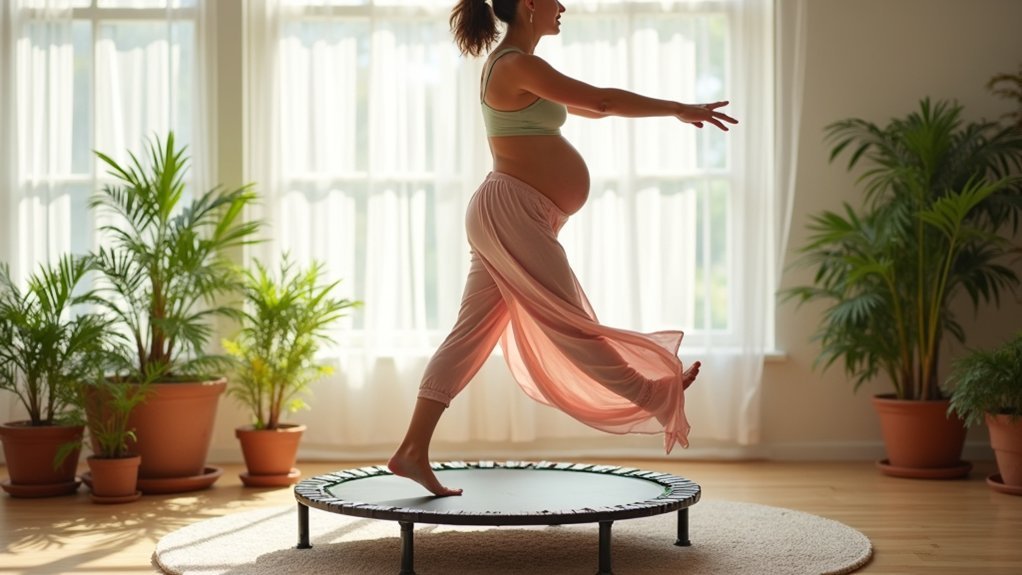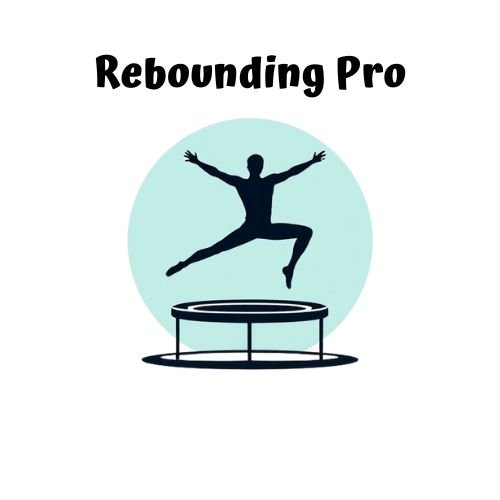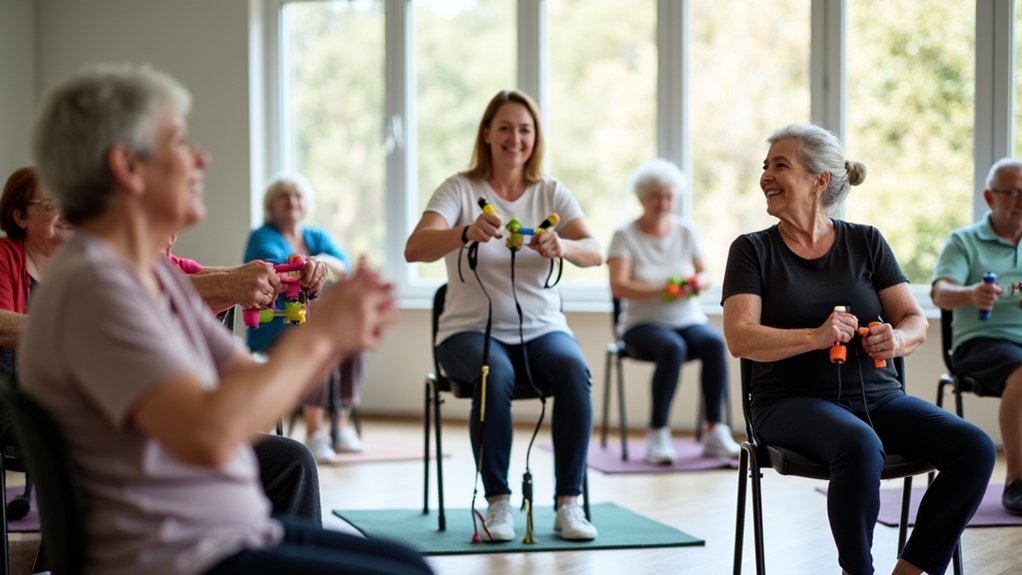During pregnancy, you can boost energy with three safe rebounding exercises: Health bouncing (gentle up-down movements without leaving the trampoline), step-based exercises (alternating foot taps), and seated bounces (sitting while gently bouncing). Always maintain proper posture, use support handles if needed, and reduce intensity as your pregnancy progresses. Check with your healthcare provider before starting any exercise routine. Discover how to adjust these techniques for each trimester to maximize benefits while protecting you and your baby.
Gentle Rebounding: How Mini-Trampolines Support Prenatal Energy

When expectant mothers seek safe exercise options, mini-trampolines offer a surprisingly effective solution for maintaining energy and fitness. The vertical motion burns calories efficiently without straining your joints—crucial during pregnancy when your body carries extra weight.
Just 15 minutes of gentle rebounding improves oxygen circulation throughout your body, combating fatigue while boosting cellular energy production. You’ll notice reduced swelling as the rhythmic bouncing enhances lymphatic drainage and blood flow. Mini-trampolines provide exceptional stability for pregnant women due to their low-to-the-ground design, making them safer than traditional trampolines.
Mini-trampolines aren’t just physically beneficial; they’re mood enhancers too. The repetitive, meditative motion helps lower stress hormones while releasing feel-good endorphins.
Many pregnant women report improved sleep quality and reduced anxiety after incorporating rebounding into their routines.
Best of all, you can easily adjust the bounce height to accommodate your changing needs through each trimester.
Modified Bounce Techniques for Each Trimester
As your pregnancy progresses through each trimester, your exercise needs change dramatically, requiring specific modifications to jumping and bouncing activities.
In your first trimester, replace jumps with step-based movements and focus on neutral alignment to reduce pelvic floor stress. Pregnancy causes the pelvic floor to respond less effectively to high impact movements. Begin incorporating kegel exercises for pelvic strength.
During your second trimester, use elevated surfaces for planks and burpees, shorten jump height or substitute with marches, and utilize support for balance as your center of gravity shifts.
By your third trimester, eliminate all jumping exercises completely.
Switch to low-impact alternatives like swimming or prenatal yoga, limit cardio sessions to 15-20 minutes, and stop immediately if you experience dizziness or contractions.
Throughout all trimesters, maintain controlled pacing, avoid the Valsalva maneuver, and guarantee proper breathing techniques.
Creating a Pregnancy-Safe Rebounding Routine With Professional Guidance

Professional guidance remains essential before beginning any rebounding routine during pregnancy, especially since this low-impact exercise offers unique benefits when properly modified. Always obtain medical clearance after your 6-week postpartum check-up and consult healthcare providers to assess your individual fitness level. The decision to use a rebounder should reflect your personal fitness history and current health condition.
| Trimester | Focus Areas | Safety Considerations |
|---|---|---|
| First | Gentle health bouncing | Maintain stability with handles |
| Second | Circulation enhancement | Monitor heart rate and hydration |
| Third | Pelvic floor support | Reduce bounce height, prioritize balance |
Design your rebounding environment carefully with a stable, high-quality rebounder in an uncluttered space. Start with light contact bouncing, gradually adjusting intensity based on how you feel. Remember to incorporate warm-ups, proper footwear, and immediate cessation if discomfort occurs.
Frequently Asked Questions
Can Rebounding Help With Pregnancy-Related Edema or Swelling?
Rebounding might help reduce pregnancy-related edema through improved lymphatic circulation, but there’s limited research on its effectiveness. You’ll want to use a stabilized mini-trampoline and get your doctor’s approval before starting.
How Do Hormonal Changes Affect Balance During Rebounding Exercises?
Hormonal changes loosen your joints and shift your center of gravity forward during pregnancy. You’ll feel less stable while rebounding as progesterone relaxes your muscles, making balance more challenging during these bouncing exercises.
Are There Specific Shoes Recommended for Pregnancy Rebounding Workouts?
Yes, you’ll want shoes with excellent cushioning and stability for rebounding during pregnancy. Brooks Adrenaline GTS 23, Hoka Cliftons, and On Cloud shoes offer the support and shock absorption you’ll need.
Can Rebounding Exercises Help Prepare for Labor and Delivery?
Yes, rebounding can help prepare for labor. You’ll build endurance for contractions, strengthen your pelvic floor, improve balance, and practice breathing techniques. The controlled movements mimic skills you’ll need during delivery.
How Soon After Cesarean Delivery Can Rebounding Exercises Resume?
You’ll need to wait 6-8 weeks after your cesarean before resuming rebounding. Always get your doctor’s clearance first, then start gradually with very short, gentle sessions to protect your healing incision and core.
In Summary
You’ve discovered how gentle rebounding can safely boost your pregnancy energy while protecting your changing body. Remember to modify your bounce techniques as you progress through each trimester, and always consult your healthcare provider before starting. With professional guidance, you’ll create a sustainable mini-trampoline routine that energizes you without risk. Listen to your body, respect your limits, and enjoy this gentle way to stay active during pregnancy.





Leave a Reply